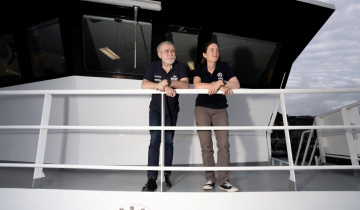Scientists completed a successful three-week field tagging trip in April 2011, where they tagged a record 27 great white sharks around the Titi (Muttonbird) Islands off the northeast coast of Stewart Island.
The National Institute of Water and Atmospheric Research (NIWA), Department of Conservation (DOC), and University of Auckland scientists are investigating the habitat and behaviour of the sharks. They are studying the periods during which they inhabit 'hotspot' locations such as Stewart Island, whether the sharks are residents or transient at these locations and the size of the population inhabiting New Zealand.
Tagging a shark is not an easy job
First, the sharks have to be attracted to the boat with a berley of tuna oil and minced tuna. When the shark is close enough, a long pole is used to stab the tag into the shark, injecting it under the skin. The shark has to be at the right angle to the boat, as the pole is used to stab the anchor into the muscle below the dorsal fin. That part of the shark is only exposed for a short time as it swims by.
On this trip, New Zealand scientists tagged the great whites using acoustic tags.
"Previously we have used "pop-up" tags. They stay on the shark for a predetermined time and record depth, location, and temperature, so they are useful for tracking shark movements to the tropics and back. After about a year the tag "pops up" and transmits its data via satellite," says NIWA Principal Scientist Dr Malcolm Francis. The cost is about $5000 for each tag.
"But on this trip we mostly used acoustic tags as we wanted information on a small scale, which we get with acoustic tags – it's accurate to within a kilometre - and they are cheaper at $400 a tag," says Dr Francis.
Dr Francis says "on our best day we tagged five sharks. Our previous record for an expedition was nine sharks tagged at Stewart Island in 2009. The acoustic tags send out a coded pinging sound that is unique to every shark. Data loggers can record when each shark is present by detecting their pings. The data loggers have a range of up to 1 km, and we deployed 25 of these on moorings around northeastern Stewart Island and Foveaux Strait. The tags' batteries last for two years, and the data loggers will be left in the water for that duration. We will download data from the data loggers at 3–6 month intervals.
"We hope that we will collect a detailed and exciting dataset that tells us where each shark was and when. Because of their tropical migratory behaviour, we anticipate that we will get a lot of hits on the receivers during autumn and early winter, with not much happening over late winter to summer while the sharks are away in the tropics.
"Several great white sharks tagged with popup tags in previous years have returned to Stewart Island, indicating that some sharks return to their tagging location after their tropical holidays. Two 4 metre female sharks, nicknamed Miranda and Ella, have been seen at the Stewart Island tagging site each year for four years. Many other sharks have been seen on more than one expedition to Stewart Island," says Dr Francis.
Smile you're on camera
The scientists are building a unique picture.
Great white sharks are individually recognisable from their colour pattern, particularly around their gills and on the tail, and the pattern of notches on the trailing edges of their dorsal fins.
Department of Conservation scientist Clinton Duffy says the scientists are "compiling a catalogue of photo-identifications. We are using underwater video cameras to try and determine how many sharks occur around Stewart Island. By combining the photo-IDs and the acoustic tag records, we should be able to build up a detailed picture of which sharks are seasonal residents, where they hang out, and how long and when they are there.
"This will provide an intriguing insight into the lives of these magnificent animals, and improve our understanding of their habitat requirements. We should also be able to make an estimate of the size of the population around Stewart Island from the ratio of re-sighted sharks to new, unknown animals."
Pop-up tags
Scientists are studying the movement tracks of the migratory sharks.
On this expedition, three "pop-up" tags were deployed. "One of these was on Ella, a shark that has been tagged previously. She was tracked to the remote Chesterfield Islands in the Coral Sea, between the Great Barrier Reef and New Caledonia. We know Ella has made at least one tropical migration, and returned to Stewart Island, so it will be fascinating to find out whether she makes another migration this year, and if so, whether she goes to the same reefs, or to some other tropical location," says Mr Duffy.
While the scientists were at Stewart Island, Ricky Topi, a farmer on Ruapuke Island, recovered one of their popup tags. The tag had been deployed on a 3.8 m male (Geoff) exactly a year earlier at Stewart Island.
"The tag popped up in Foveaux Strait and started transmitting, but although we could hear it transmitting we were unable to locate it. A strong southwesterly wind washed it eastwards to Ruapuke Island where Ricky found it on the beach. Recovering a popup tag is a great boost for the study: the tags record depth and temperature every minute, and get two location fixes per day. This high-resolution data is much better than the summarised data that can be transmitted via satellites (the latter is limited by battery power). It was exciting to download the data and process the information to find out where Geoff had been. He spent 7 months on the southern Great Barrier Reef and in northern New South Wales before returning to almost the spot where he was tagged. This recovery has added new information to our overall knowledge of the wanderings of white sharks," says Mr Duffy.
Dave, a 2.8 m male shark tagged last year, swam to New Caledonia where his tag popped off in September 2010. Colleagues in Noumea retrieved the tag from a beach where it had washed ashore, and returned it to New Zealand for data download. The scientists found him at Stewart Island again this year, so they now know that he made a round trip to New Caledonia and back.
Successful great white shark expedition
This successful research trip by DoC, NIWA and the University of Auckland has revealed more detail about the complex lives of great white sharks.
"The pieces of the puzzle are gradually coming together. We knew that most of our white sharks emigrate from New Zealand during winter and travel several thousand kilometres for a tropical holiday. Now we have discovered that many, perhaps most of them, make the return trip to exactly the same place in New Zealand," says Dr Francis.
NIWA's research is funded by the Ministry of Science and Innovation (MSI).
Background
The research programme began in 2005 and has involved expeditions each year to the Chatham Islands or Stewart Island, two white shark hotspots. White sharks aggregate in these areas during autumn–winter to feed on NZ fur seals, which form large colonies on rocky islands.
Before the present expedition, 31 white sharks had been tagged with popup archival tags that record location, depth and temperature for a pre-determined period, and then release themselves from the shark, float to the surface, and transmit summaries of the data to a satellite.
Previous work has shown that nearly all white sharks migrate northwards to warmer waters during winter–spring and spend several months in the tropics. Destinations include the southern Great Barrier Reef in Australia, New Caledonia, Vanuatu, Fiji and Tonga. During their migrations, great white sharks make deep dives to over 800 m, with a record of 1200 m being achieved by one shark migrating to Australia. Scientists don't know what they do on these deep dives, or why they spend so much time in the tropics, but it is likely related to feeding, perhaps on squid and fish in deep water, and large fishes (marlins, tunas, groupers and snapper) and marine mammals (whales and dolphins) in the tropics.
Great white sharks were protected in NZ waters in 2007, and cannot be targeted by fishers. However, some sharks are still being accidentally caught in set nets and on lines. Great white sharks have very low productivity, producing only around 10 pups per litter and breeding probably every 2–3 years. They grow moderately slowly, maturing at 10–20 years, and living perhaps as long as 30–50 years. We have no estimates of population size in NZ, nor whether the population is stable or declining as a result of incidental fishing mortality.









